Dandelions are considered an invasive and frustrating weed by most gardeners, but there are still a few who believe that their benefits outweigh their bullishness. I am firmly in that camp. Dandelions are a vital source of pollen and nectar for bees, moths, and butterflies, and contribute to a healthier ecosystem in our gardens.
With the potential to brew delicious teas, vary your salads, and even create traditional drinks, there is much more to dandelions than first meets the eye. So, share in our drive to re-establish these glorious plants into our gardens, whether you want a natural wildflower meadow, or a few pots of edible greens, and learn how to grow dandelions.
More...
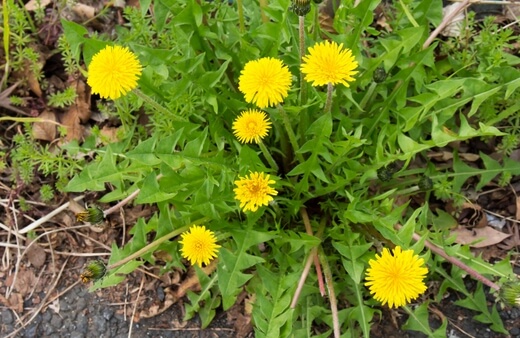
Family: | Asteraceae |
|---|---|
Genus: | Taraxacum |
Common Names: | Dandelion |
Location: | Outdoor |
Type: | Herbaceous perennial or biennial |
Growth: | 5cm-40cm tall |
Sun requirements: | Full sun or partial shade |
Foliage Colour: | Green |
Flower Colour: | Orange or Yellow |
Flowering: | Spring to late Autumn |
Fruit: | None (edible roots) |
Maintenance level: | Low |
Poisonous for pets: | Non-toxic |
What are Dandelions?
Dandelions are a very wide species group of wildflowers, with bright yellow flowers from spring through to autumn, dense, low-growing green foliage, and puffed seed heads. They spread easily through lawns and gardens in nature and in gardens, and are often considered to be a weed.
Taraxacum is the scientific name for Dandelions, and the genus contains over 2800 species. Some are biennial, others perennial. A handful produce sexually (requiring another male or female plant to successfully pollinate) and the 2800 species can be divided into roughly 60 groups.
Benefits of Dandelions
Dandelions can be used in a number of ways in the kitchen, with potentially positive health benefits too. Their leaves, flowers, and roots are all edible, and in small quantities can work as an antioxidant that is packed with vitamins.
Later in this article, we’ll share some cooking ideas, as well as the best way to grow and harvest dandelions, but in short – they can be eaten raw or cooked, and every part of the plant is a delicious addition to most recipes.
As well as positive health benefits, dandelions are great for wildlife and have many benefits to nature, including attracting many species of predatory insects to limit aphids, thrips, and other garden pests.
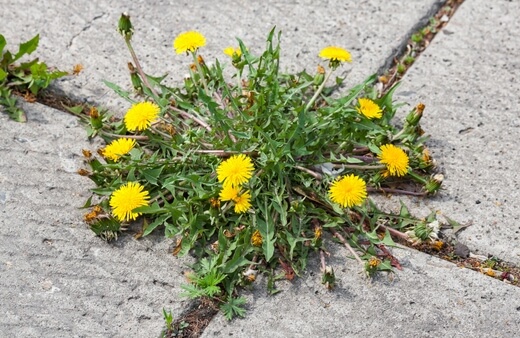
Natural Habitat of Taraxacum
Dandelions are found all over the world with unique species groups found on every continent, but Europe has a higher count of species than anywhere else on earth, with 235 species native just to Great Britain and Ireland.
There are two species of Dandelion that are native to Australia, Taraxacum cygnorum and Taraxacum aristum.
Dandelions can grow in most soil types but prefer neutral to slightly acidic soil. However, it is not unusual to see dandelions growing from gutters, in bogs, or from crevices in tree bark as their seeds will germinate successfully in nearly all growing conditions.
Are Dandelions a Weed?
Dandelions are a weed, and they will spread in your garden, however, they are no more invasive than California poppies, Welsh poppies, or foxgloves, which can pop up in lawns and borders too. It’s important to remember what a weed really is; just a plant in the wrong place.
With proper management, dandelions can be a beautiful addition to the garden and can be controlled with irregular management and deadheading to reduce the possibility of seeding.
Types of Dandelions Native to Australia
There are two species of dandelions native to Australia; Taraxacum cygnorum and Taraxacum aristum. Both are threatened species. If you are able to support native dandelions in your garden, you should take every possible opportunity whether it’s in pots, lawns, or borders.
Taraxacum cygnorum
The Coast Dandelion, Taraxacum cygnorum was prolific until the mid-1900s, but habitat loss, increased wildfires, and herbicides on farming sites have resulted in this once widespread native plant being near extinct.
Taraxacum aristum
Also known as the Mountain Dandelion, Taraxacum aristum is a protected species. This means that any wild dandelions you see in Australia should be treated with caution, and left to self-seed, or even supported in propagation.
How to Grow Dandelions in Australia
Dandelions will grow in pretty much any conditions, with or without soil, and in any reasonable neutral pH. They don’t require particularly fertile soil either. Having said that, there is still a right way and a wrong way to grow dandelions, especially if you plan on harvesting them for edible greens.
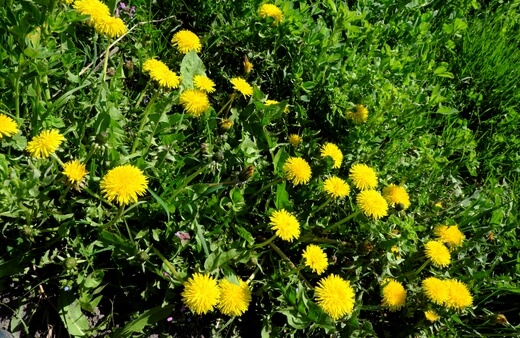
Growing Dandelions Outdoors
Start by finding a good bright position, with shade from the afternoon sun. If you are growing dandelions in pots, plant them about 5 cm apart. Their leaves will compete, but you’ll have a better display of flowers, and still get loads of healthy foliage to munch on.
Fill containers with any sieved garden soil and mix in plenty of grit or sand if your soil is clayish or boggy in any way (the only conditions dandelions don’t really like is waterlogged).
How to Propagate Dandelions
The best way to start dandelions is from seed. But please be careful when buying dandelion seeds online that any native species are from reputable sellers with the appropriate permits to sell or trade in the seeds of protected species.
Native dandelions are threatened with extinction through habitat loss and agricultural herbicides.
To propagate dandelions:
- Sow directly where you want them to grow in early spring. Either fill a pot with garden soil or sow the seeds directly onto any soil in the garden (they will even propagate well on lawns if you water them in to provide good soil contact)
- Water the seeds well when you put them down.
- After about 4 weeks, you should be able to recognize these seedlings as dandelions, with their jagged leaves.
- For wildflowers, leave dandelions to compete naturally.
- For edibles, thin dandelion seedlings to 5-10 cm apart to reduce competition.
How to Care for Dandelions
Dandelions need very little care after planting, and will invariably grow, develop and flower successfully regardless of your skills as a gardener, but there are some ways to make the most of them as edible crops.
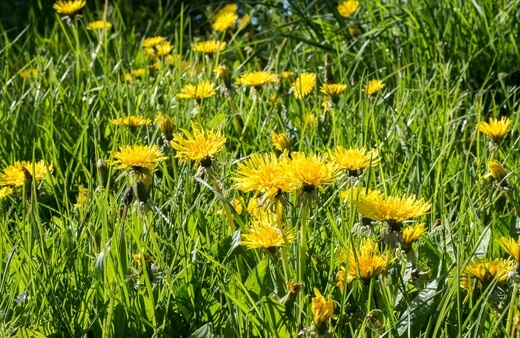
What Fertiliser to Use
After planting, you can boost foliage growth with any basic vegetable feed or organic fertiliser. Liquid seaweed is good for boosting overall health and helps to produce crisper leaves.
Tomato fertiliser will support flowering, which is useful for dried flowers if you plan on making teas, or decorating cakes.
Watering Dandelions
Watering dandelions is only necessary if you are growing them as edibles. As wildflowers, they will recover quickly from droughts. To save water when growing edible dandelions, water them deeply once a week, rather than a little every day.
This encourages them to stiffen their leaves and creates a much better salad crop.
Deadheading Dandelions
The most important part of caring for wild gardens, or wild plants in your garden is deadheading. For truly wild gardens, you can leave dandelions to go to seed naturally, and they will continue to spread evenly throughout the garden.
For a more controlled style of planting, deadhead all your dandelions, and leave just two plants to go to seed. Save those seeds, and plant them where you want them. This avoids the risk of being overrun with young plants next year.
The middle ground, where you are using dandelions as edibles, but still want colour all year round, is to deadhead all flowers until March. This will keep your dandelions flowering, and then give them a chance to set seed again naturally for the following year before winter.
How to Harvest Dandelions
There are a few different ways to harvest dandelions. Your chosen methods will depend on how you plan to use them, so check the preparations and suggested uses below before harvesting each part of the plant.
Harvesting & Preparing Dandelion Flowers
For flowers, deadhead regularly and add to salads as fresh flowers. Their sweet flavour is quite surprising, with a tangy but honeyed burst that is unlike any other edible flower.
Dandelion flowers can also be dried for long-term storage, and used to make teas and infusions, and work well added to gin or vodka as a simple floral infusion (leave for about 6 weeks for best results).

How to Harvest Dandelion Leaves
Dandelion leaves are easy to harvest, but for a longer harvest window, take 1/3 of the leaves from each plant at a time. Taking more can slow down recovery and leave you waiting longer for your next harvest. The leaves can be dried to make a slightly bitter but pleasantly earthy tea, with useful antioxidant properties, or used fresh in salads.
Dandelion leaves are also a delicious alternative to spinach, wilted down as greens on the side of any dish, or stirred through casseroles and curries for an earthier, peppery alternative to spinach or spring greens.
Harvesting Dandelion Root
For any root preparations, dig up the entire plant with a hand fork, and wash the roots thoroughly before drying them. Dry them on a bright windowsill, or in the oven on a low heat for 1-2 hours to dehydrate them.
They should last for about 6 months when dehydrated and can be ground up to make a stunningly complex coffee alternative that’s caffeine free, but packed with vitamins for an alternative energy boost.
Benefits of Dandelion Tea
Dandelions could be seen as the ultimate natural ingredient for many of our ailments. Those dreaded yellow flowers can easily become the elixir-of-life known as ‘dandelion tea’.
Pregnancy, menstruation pains and bloating, constipation, liver complaints and even weight-loss have been eased by drinking regular cups of this tea – and by regular, I mean one per day. It’s a natural herbal tonic that offers laxative and diuretic properties and helps reduce toxins and gases in the body.
How to Make Dandelion Tea
Most dandelion tea is made from the root of the dandelion weed or the yellow flowers. Dig up a few of these weeds, wash out any grit and soil and then cut away the foliage. Then the roots and flower petals can be steeped in boiling water for 2-3 minutes before being drained off. You can leave them in the pot for longer but the bitterness will increase if you leave them too long.
Storing Dandelions
As dandelions mainly grow and flower towards the end of winter through late summer there will be a period where fresh stock can’t be obtained. In this case, dry some surplus roots and store in a cool location to get you through the autumn and winter months.
Dandelion tea made with dried root will taste considerably stronger, so you shouldn’t need to use as much, but it will also have a darker colour – mere aesthetics.
Dandelion Tea Bags
Dandelion tea bags are another option for months when this herb doesn’t grow and they are often sold in grocery or online. The tea bags usually come in packs of 30 allowing you a month’s worth of stored tea.
Side Effects of Dandelion Tea
Are there any side effects to drinking dandelion tea? Sure, like anything it should only be taken in moderation. If you consume numerous cups per day then instead of benefiting your inner organs you could instead be harming them considerably.
Also, if you’ve used chemical herbicides or pesticides on these plants then more rigorous washing is needed before you make a tea out of them. In fact, I would even suggest that you leave them alone altogether, just to be safe, and then begin harvesting dandelions from the next season onwards.
It goes without saying that dandelions found in public open spaces may also be contaminated and should probably be left alone as well.
Common Dandelion Pests and Diseases
Like most weeds, dandelions are successful because they are resistant to the vast majority of pests and diseases. Other than small mammals and herbivorous garden visitors, there are no common pests that will harm the health of dandelion plants.
Slugs and snails can leave unpleasant slim trails, and will occasionally munch on the leaves, but rabbits are their main enemy, thanks to small amounts of latex secreted from their roots which deter burrowing insects and larvae.
Dandelions Frequently Asked Questions
How long does it take to grow dandelions?
Dandelions take about 80 days to grow from seed to harvest. While they germinate quickly and develop lush foliage, it’s worth waiting until the three-month point to harvest as their roots are slower to establish than the rest of the plant.
Harvesting after 90 days or more will increase the chances of a second flush of flowers and renewed foliage.
Can you grow dandelions all year round?
Dandelions can grow all year round in Australia but are typically found from spring to autumn growing and flowering outdoors. Winter flowering dandelions are not uncommon in warmer parts of the country, but they will need good drainage to cope with heavier rainfall.
Why are dandelions a problem?
Dandelions are a problem, or, rather, dandelions are seen as a problem, because they spread easily through gardens and can be hard to control. Their long tap roots are also quite tricky to remove.
Personally, I see that as a bonus as these plants are easy to grow, and add tons of colour to any garden.
What time of year do you plant dandelions?
Dandelions germinate after about 10 days when planted in early spring. They will show their true leaves after about three weeks, and should then be left to establish for 2-3 months before harvesting leaves, flowers or roots.
Should you leave dandelions alone?
Dandelions are one of the most chastised plants in the world, but they should be left well alone in our gardens, and encouraged rather than removed. Australian native dandelions are a threatened species and have lost so much of their habitats that we have a responsibility to help them to recover.
Do dandelions replenish soil?
If your garden has poor, compacted soil and it’s hard to grow anything well, try sowing dandelions. Dandelions help to break up soil and improve its structure.
While they don’t do much for nutrient levels, they will loosen up compacted topsoil, and can be left to create a tough flowering lawn, or removed by hand later to plant up your new and improved garden.
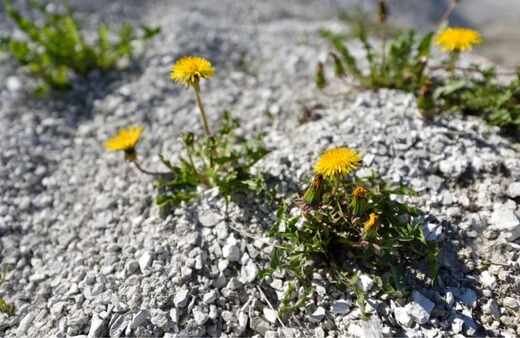
Do dandelions grow back after mowing?
Dandelions grow back after mowing, and it will often improve their flowering habits. Regularly mowing back dandelion lawns will keep them flowering more regularly through the year, and also prevent their seed from spreading, so you’ll have the best of both worlds: an easily manageable garden, plus wonderful flowers.
Why shouldn’t you pick dandelions?
Dandelions are a great source of nectar and pollen for bees and pollinating insects. Mowing dandelions too often or removing them completely removes a vital source of native nectar from your garden.
If you grow vegetables, dandelions are actively beneficial because they bring pollinators into the garden.
Are dandelions poisonous to dogs?
Dandelions are not poisonous to dogs. While the leaves are better for dogs than flowers or roots, dogs can eat the entire plant safely. Dandelion leaves can actually be beneficial, and they will often instinctively eat them if they feel any sort of stomach upset or imbalance.
Do dandelions bloom twice a year?
If left completely alone, dandelions will bloom twice a year. One in spring, and again in autumn. With regular deadheading though, dandelions can provide constant colour right through spring, summer, and autumn.
What do dandelions tell you about your soil?
Weeds of any type growing in your garden, or in vegetable beds is a good indication of good soil. However, if the only thing that will grow is dandelions, that could indicate overly compacted soil with mineral deficiencies (calcium and magnesium).
Can rabbits eat dandelions?
Dandelions are one of the best plants you can grow at home for pet rabbits. Rabbits absolutely adore fresh dandelions, whether they’re roaming around your lawn, or if you’ve picked them and added them to their hay.
Wrapping Up Our Dandelions Growing and Care Guide
Dandelions deserve a rethink. We have spent the last hundred years chastising dandelions as weeds, and forgetting that we share our gardens with nature. Our job as gardeners is to nurture the world we pass through, and if that means encouraging a few ‘weeds’ then so be it.
I firmly believe that dandelions have every right to be in our gardens, and love seeing them flowering as a sign of early spring. Dandelions' edible greens are a big bonus, but by no means overshadow their use as an unusual herbaceous border plant.
Published on January 31, 2023 by Maisie Blevins
Last Updated on February 22, 2024




